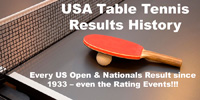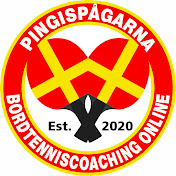Tip of the Week
Coaching Yourself, Part 3 of 5: Serve Practice
Next Blog – January 5, 2026 – and the US Open
=>But Tips Will Go Up Every Monday
I’ll be gone the next few weeks. I’m off to the US Open Wednesday morning, and then Christmas in Sonoma, CA with my brother and family (near San Francisco). So, next blog will be Monday, Jan. 5. But the Tip of the Week will go up every Monday. For the five Mondays in December, I put together the five-part “Coaching Yourself” series. Part 3 went up today!
The US Open starts tomorrow, Dec. 16-21, Tue-Sun, six days, with 1,293 players. However, this year I’m not coaching as much, and I don’t play until the last three days, Fri-Sun. So, I’m flying out Wednesday morning. I was originally entered in nine events – all senior or hardbat events (plus the sandpaper event), but due to the injury to my side, I dropped all the sponge events, and so am only playing in three hardbat events – Open, Over 40, and Over 60 (I’m defending champion in the last two), and sandpaper singles. On all my forehand shots I have to cut my follow-through short or tear the side injury, plus I can’t rotate quickly to my left. The effects are worse with sponge. But I’ll likely aggravate the injury anyway. Alas. (You can follow the results in Omnipong – go to the very first entry at the top for US Open, and in a day or so, where it says “Closed” will change to “Results.”)
The Real Life Inspiration for Marty Supreme - Table Tennis Star Marty Reisman
Here’s the video (15:17) from former hardbat star and my long-time doubles partner Ty Hoff! Learn about the real Marty Reisman. Very nice video if you want to learn about the real Marty, who I knew well. One thing I learned from the video was that his interest in microscopy was from his childhood – somehow I’d always thought it was something he’d picked up as an adult. I was at his house once and he showed me a bunch of slides under one of his microscopes.
As to the video, yes, that’s me playing him in the 1997 final, from 12:50-13:03. He won – but someone, probably one of his minions, stole my racket just before the match, and I had to play with a borrowed racket that was completely different than mine and played like a brick. I was the defending two-time champion at the time, though it had been five years since they’d held the event. I’d sure like to replay that match with my racket...
Over the last ten days I’ve been interviewed twice about him, by Smithsonian Magazine and by Rolling Stones Magazine, with both articles coming out about the time the movie comes out on Dec. 25. I may add links here when they come out, or will put them in my Jan. 5 blog.
Weekend Coaching
I coached in three junior group sessions over the weekend. One recurring theme was playing down the line, and attacking the wide backhand. When you play to the wide forehand, many players automatically return crosscourt, which is easier – there’s the longer diagonal, plus it’s generally easier to rebound a ball back the way it came. But when you play from the wide forehand, the opponent has to cover the angle to their wide forehand, and this usually means they are wide open if you attack down the line. This was always one of my favorite shots, and I spent some time showing players how you can set up to go crosscourt, and at the last second rotate your shoulders back, and taking the ball just a little bit later, take it down the line.
I also watched for an hour the autistic junior program founded by Stanley Hsu, and run by him and Mu Du, with assistance from a number of others from our regular junior program. I plan to write an article about the program sometime early next year.
I came up with three table tennis jokes during the training sessions. Sorry, I can’t help it!
- "Evolution will not be kind to that ping-pong ball." Me about a ball that randomly and trustingly rolled into a ball net.
- "The best way to kill a high ball is to catch it and step on it."
- "Gravity pulls the ball down, but what happens if you remove it? You get gravy." [If you don’t get it, think about it.]
And speaking of table tennis jokes, I came up with this...
Dogs and Table Tennis
How dogs play table tennis.
- Border Collie: "I’m going to serve short to the forepaw. You’ll fake a return to my wide forepaw, but I know you’re faking, and as you hit the ball I’ll move over and play a backpaw to your middle, which should force a slightly weak return. I’ll fake a smash to your forehand, with head fake, but then go to your backhand. If you get that back, I’ll chop block short, drawing you in, and then . . . (continued on next page)"
- Australian Shepherd: "Let me round up all the balls on the floor."
- Pointer: "There’s the ball."
- Poodle: "I look adorable in my table tennis outfit!"
- Golden Retriever: "Life is great, ping-pong is great, and we’re going to have a great match!"
- Dachshund: "What are they doing up there?"
- Rottweiler: "I must break you."
- Pit Bull: "I ate the ball."
- Lab: "Oh boy oh boy oh boy, can we play? Yes, yes, let’s play!!! Can I serve? You can serve! Hurry up and serve!"
- Old English Sheep Dog: "I don’t see a table or ball anywhere."
- Greyhound: "I’m going to play all forehand shots."
- British Bulldog: "I'm keeping the ball."
- Saint Bernard: "Did I serve another wet ball? Sorry."
- Cat: "Go away."
One-Step Program to USATT Success
- Give President Trump the USATT Ping-Pong Peace Prize in return for one billion in funding, declaring table tennis the national sport, and turning the White House Ballroom into a full-time table tennis club.
Butterfly Training Tips
- Arantxa Cossio Aceves – All Table Forehand Loop (64 sec)
- Yu Di – Forehand Sequencing (75 sec)
- FETHOMANIA 18 / Drill 3: Use the Movement to Turn Your Body (42 sec) with Stefan Feth and Larry Thoman
- FETHOMANIA 18 / Drill 2: The Key Against Heavy Backspin… (38 sec) with Stefan Feth and Larry Thoman
- FETHOMANIA 18 / Drill 1: Drive the Ball More Forward (38 sec) with Stefan Feth and Larry Thoman
Footwork for Short Returns
Here’s the video (2:44) from Pongspace. “Yang Xiaoxin teaches you how to receive a short serve to the forehand side and what everybody usually gets wrong.”
Seth Pech vs Junior National Team member Ryan Lin Joola Teams Semi Finals Match
Here’s the video (10:04). Some really good analysis here.
New from PingSunday
29 new videos in past week!
New from PingSkills
Ask the Coach
Zhang Jike: The Rise, The Record, The Silence
Here’s the video (4:59) from Beyond the Podium.
Major League Table Tennis
- Home Page
- Major Pong Head (blog coverage)
- SCHEDULE
- Ivy League Alumni Bring MLTT Format to Portland
- Major League Table Tennis Partners with IC360 and ALT Sports Data To Support
New from Steve Hopkins/Butterfly
- Harimoto Wins WTT Finals
- WTT Finals: Chuqin, Shidong, Moregard, Harimoto Semifinalists – Koreans Win Doubles
- Top 16 Battle at the WTT Finals
USATT News
- USA Table Tennis Launches New Membership Tiers Effective January 1, 2026
This is highly controversial. USATT announced this on their Facebook page, and let’s just say the responses have been very negative. It’s a big membership increase. - USA Table Tennis Announces Partnership with JustGo
- 2026 YOUTH NATIONAL TEAM SELECTION PROCEDURE RELEASED
ITTF News
- Priority Window Now Live for the ITTF World Team Table Tennis Championships Finals London 2026
- A Run That Demanded Respect: Croatia's Stunning Sixth Place Finish in Chengdu
- ITTF Global Youth Training Camp Returns to Chengdu, Inspiring the Next Generation
- Ticketing Dates Announced for the ITTF World Team Table Tennis Championships Finals London 2026
Dinosaur Table Tennis Coasters
How can any serious player not have a set of these?
Wang Chuqin Builds the Perfect Table Tennis Player
Here’s the video (37 sec) featuring the world #1 from China!
Unreal Behind-the-Back Return
Here’s the video (11 sec) featuring Alberto Gil!
Adam Bobrow and Alex Lebrun
Here’s the video (18 sec) as Adam and the world #6 from France goof off.
Mostly Non-Table Tennis – “Cats and Bats”
My new short story collection is out! Cats and Bats has five stories that feature cats, and five that feature baseball. (There are a few passing mentions of table tennis.) All are in the science fiction & fantasy genre. From the back cover: “In Larry Hodges’s wonderfully unhinged world, a president’s pet saves the world, enhanced cats conquer humanity, baseball players sell their souls for stardom, and mathematicians and a mummy take over baseball. Equal parts sci-fi, fantasy, satire, and sheer lunacy—these five cat and five baseball stories will have you laughing, cringing, and wondering what on earth (or beyond) comes next.”
This is my 24th book – here are links to all of them. They make excellent Christmas presents! I have three upcoming ones, two on table tennis:
- Jan. 1, 2026, “Amazingly Even Yet Still More Pings and Pongs,” the sixth book in my general short story collections, with 20 more of my short stories. (I use “Pings and Pongs” as a name for my general short story collections, even though they are not primarily table tennis.)
- March, 2026: “Ping Pong Paddles Can’t Talk!” – children’s picture book that introduces kids to table tennis, with a boy playing in his first tournament and dealing with nerves, the tournament director, referee, a girl who is really good . . . and his talking ping-pong paddle!
- April, 2026 – “Even Yet Still More Table Tennis Tips” – the Fifth in my “Tips” series, with another 150 tips.
Mostly Non-Table Tennis - Recent Sales and Publications – December 2025
Here’s my science fiction writing blog that went up today, which includes links to four new stories published recently, and info on three other sales.
***
Send us your own coaching news!





